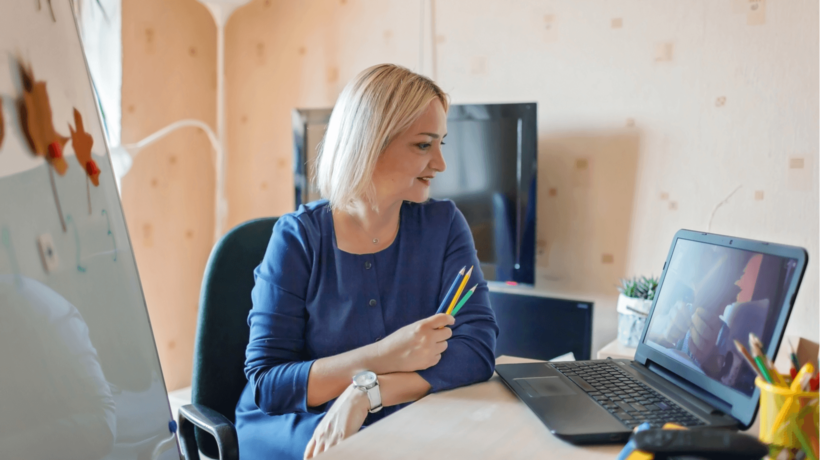What Parents Need To Know About Blended Learning
Parents often complain that their children spend endless hours in front of PCs, mobile screens, tablets, and the internet. With schools jumping on to blended learning classrooms and Bring Your Own Device (BYOD) teaching culture, problems seem to have multiplied. A concerned parent of a child whose school jumped on to the cyber-wagon recently told me “It has become hard for us to know whether our daughter is doing her studies online or browsing the web just for fun”. Another parent told me about their teenage son who was using the pretext of BYOD to buy new smartphones and tablets in order to flaunt. And when such stories get coupled with research news about how taking mobile phones away could improve kids’ grades, the whole thing becomes even more alarming. Most parents are confused about how to react towards using technology for teaching: Is it a good thing for studies? Is it just a passing fad? Is this a serious approach to studying?
The following 5 tips may help parents of kids studying in digitally-enhanced classrooms to swim the currents of uncertainty:
- Know that technology in classroom is to support learning (and not all cool tech toys support learning).
Number one tip for becoming a “careful” parent of a cyber-school child is to never be fooled by a kid telling you he/she needs that new gadget to study better. The major goal of educational technology is to facilitate the educational goals and learning outcomes of a classroom. Every new cool gadget or tech toy does not automatically become an edTech tool. Education technology tools are carefully selected by schools and educators to enhance learning outcomes. It does not work the other way round. That is, you cannot simply buy a newly available gadget and be sure that your kid will study when using it. Even when a school introduces a new edTech / eLearning tool, software program, and a learning interface, or in fact asks your child to bring their own device for studying, parents need to freely discuss this with the teachers and school authorities and get information about how this will enhance their child’s learning, as well as what the interaction and assessment process will be. On the other hand, of course, parents themselves can encourage their children to understand the educational purpose of technology and of the entertainment gadgets they already own. For instance, an iPad lying at home can easily become a programming interface to teach your kids coding with robotics. Or a smartphone is not just for texting, but can be used to learn and create useful content through various app features. - Distinguish trusted online learning sources from non-trusted sources.
As much as it is a school’s prerogative to ensure children’s safety online, digital media literacy and credible, ethical internet research is a skill that parents can easily teach their kids at home. When the school gives certain blended learning based homework tasks and online assignments, or assigns any other online learning activity, parents must sit down with their children to guide them on credible learning platforms and ethical use of internet for learning. Assist your children in completing their online assignments by directing them how to look up for information online without getting lost in the pool of web-links. Teach them how to choose between trusted learning sources and unsupported claims and theories. Make them aware of cyber security norms, malware, and phishing. Never let a child make unsupervised purchases of apps, software, eBooks, or any other “learning material”. Not only does this make the task of online learning and research simpler, more directed, and engaging for your child, but also makes it much safer. - Stay connected with your child’s school and teachers.
Most parents are cautious with cyber security threats and supervise their child’s web activities. But when it comes to eLearning platforms, parents may in fact be baffled by the inclusion of technology resources in education. The easiest way to deal with this is to connect with your child’s teacher/school. Ask the school and/or teacher to handover a resource guide that will direct you about the essentials of eLearning and educational technology resources. Also, know beforehand about any kind of gadgets, software, or other edTech tools that your child will need to bring to the classroom. Without the teacher’s saying, do not invest money in cool gadgets. Digital literacy among parents is another important skill to be able to judge the credibility of academic resources and the effectiveness of edTech tools and eLearning platforms that your children’s school is using. Always maintain a direct contact with their teachers about your children’s learning progress in the online learning environment. Keep yourself aware of the curriculum and assessment instruction strategies that the school is employing. Also, understand the measures that the school is taking to ensure your child’s safety online. If you initially find it hard to learn and understand about the technology incorporation, do not hesitate to approach the teachers or to learn about them through various online edTech educators and blogs. - Know that "blended" is not equal to "online".
Life has become so much simpler post internet and search engines. Ranging from books, book reports, study notes, answers to every other piece of information students might need for their grades, knowledge or learning is readily available on the internet. However, this is also axing the sheen of books and other offline learning materials. Most students do not want to bother with reading long drawn books when chapter summaries are easily available on the internet. So much so, I recently found one student using Reddit to seek answers to his entire homework set. Parents need to inculcate the spirit of blended learning in the right format in kids. It is about utilizing both offline and online learning technology and resources to deliver learning outcomes. This in no way means using only the internet for studying. Parents must set rules and limits to the use of technology even for studying. Talk to your child’s teachers and understand the proportion of time the child needs to divide between online and offline resources. Encourage book reading practices in children right from the start. Make frequent visits to public libraries and teach your kids the art of researching and reading in offline format as well. Encourage your kids’ school to recommend a heavy mix of offline reading resources in the curriculum as well, instead of solely depending on edTech and eLearning solutions. - Beware of self-paced and flexible learning schedules.
One of the major benefits of eLearning platforms, especially those involving asynchronous instructions, is the flexibility to schedule your lesson at any time and to set your own pace of study. But most students can take this too literally and understand “as and when they feel like it”. As a result, there can be heaps of procrastinated lessons and pending worksheets in the end, defeating the overall purpose of learning and knowledge gain. As a parent, it is your duty to set up a flexible study schedule for your child but not an overly relaxed one. Make sure that the study schedule is followed, the deadlines for submissions are met, and the learning goals are right on track. While the study pace must be tailored to your kid’s learning abilities, it is best to connect with their classmates and their parents to know whether your child is falling far behind the rest of the class.
In the end, it is most important for parents to remember that while the instructional mediums and techniques may change, the end goal is to enable learning and enhance your child’s knowledge. New educational technologies and eLearning platforms will keep coming up, but this in no way diminishes a parent’s role in their child’s education and development. If anything, it might just change the way it is done. By simply being fully aware of the pros and cons of blended learning and education technology, parents will be able to truly utilize the benefits of technology in education as well as to help their children do the same.
We would love to hear more in the comments below about your experiences as parents of students studying in blended classrooms. Also, if you are a teacher, what initiatives have you taken to help your students’ parents navigate through your edTech-based teaching techniques?









